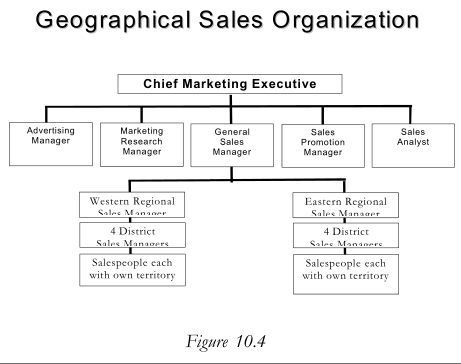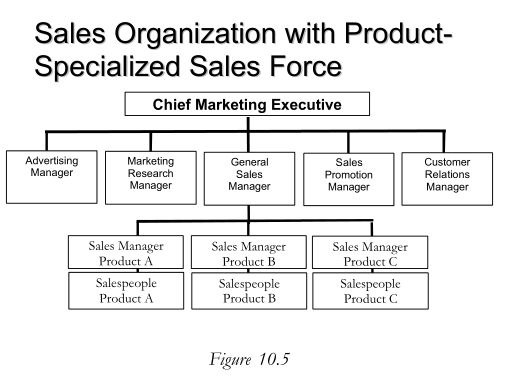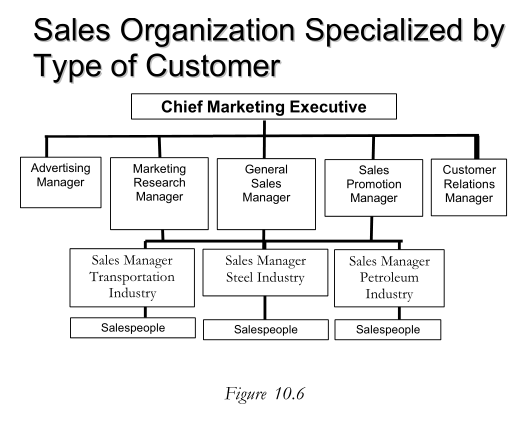As marketing operations expand, line authority and responsibility eventually be-come excessively burdensome for the top sales executive. There is an increasing number of people to supervise. Ordinarily, the first remedial step taken is to add a general line assistant, for example, an assistant general sales manager. As the burden of line administrative work continues to grow, it is necessary to provide additional assistants. These new subordinates are given line responsibilities narrower than those of the assistant general sales manager. Although they work with a variety of matters, their assignments cover a limited area of operations. Tasks of line administration are subdivided among these new assistants in one of three ways: (1) by geographic area, (2) by products, or (3) by customers or marketing channels.
Geographic Division of Line Authority
The large firm with far flung selling operations is likely to subdivide line authority geographically (see Figure 10.4). This is particularly so if the characteristics of large numbers of customers vary by geographic location, if different selling problems are encountered in different areas, or if certain products are more strongly demanded in some regions than in others. But there is an even more compelling reason for dividing line authority geographically as more customers are added and as a wider area is cultivated, the size of the sales task increases enormously. Setting up geographic divisions is a way of cutting the sales task down to manageable proportions. When centralized administration becomes too great a burden for the top sales executives, secondary line executives are delegated authority to conduct sales operations within smaller areas. Geographic division is usually made first into regions or divisions. This may or may not be broken down further into districts or branches.
Advantages
- When line authority is divided geographically, local problems are handled speedily. It is not necessary to wait for decisions from the home office; many questions of importance to customers can be answered by executives personally acquainted with local conditions.
- Shortening the lines of communication makes possible closer supervision of salespeople, which, in turn, helps in improving customer service. Local markets can be cultivated intensively, and tactics of local competitors can be met and countered in the field.
Weakness: However, this system calls for multiple offices, so administrative expenses increase. Then, too, the top sales executive faces coordinating several regional operations. Unless this coordination is effective, conflicting policies may develop in different regions.

Product Division of Line Authority: A second scheme for dividing line authority is to split the sales task among subordinate line executives, each of whom directs sales operations for part of the product line. When authority is so divided, more than one sales force may be required. Some companies’ product lines are too wide to be distributed economically by a single sales force. Others sell both highly technical and non technical products; thus some salespeople need specialized training and some do not. In still others, economies of a single sales force are reduced or eliminated because different products are marketed to different types of customers. (See figure 10.5)

The decision to use the product type of sales organization should rest on whether the benefits of product specialization outweigh the additional expenses. If they do not, it is wiser to organize the sales force on some other basis. Gains associated with specialized salespersons, who concentrate on selling specific products, must be outweighed against increased expenses. Maintaining more than one sales force results in higher administrative and travel expenses. There are almost certain to be times when two company sales personnel selling different products make calls on the same customers. Although specialized salespeople may give more “push” to individual products, many customers object to multiple calls from the same company. The benefits of specialized sales forces are greatest for companies selling broadly diversified lines, reaching different markets with different products, and encountering unique selling problems for the various products.
Customer (or Marketing Channel) Division of Line Authority: The third scheme for subdividing line authority is by type of customer (figure 10.6). This is appropriate when nearly identical products are marketed to several types of customers and the problems of selling to each type are different. When the same, or similar, products are sold to a number of industries, they often find different applications in each industry. Customers not only have different needs, they are influenced by different buying motives. Thus, special sales forces sell to each major type of customer.


